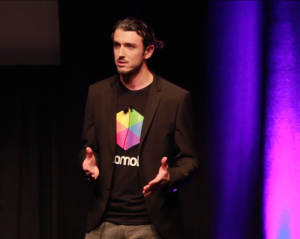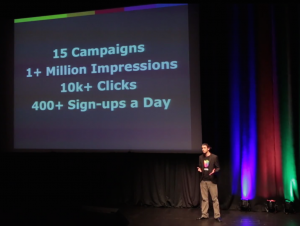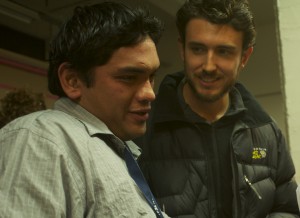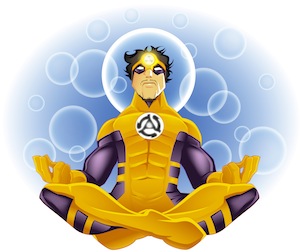
Brinkley Warren, 2012-2013, New Zealand, pitching his creative startup to the largest gathering of angel investors in New Zealand history on stage at Te Papa Tongarewa (the Museum of New Zealand)
A Fulbright grant is an opportunity-accelerator. Forbes Magazine recently ranked New Zealand as the #1 best place in the world to start a new venture, and I suppose it is fitting that my 2012 Fulbright art project transformed – most serendipitously – into a social-tech startup.
My MFA exegesis explored the notion of entrepreneurship as art form and art as entrepreneurship, and I wanted to challenge the notion of being an artist in the digital age. As founding CEO of the venture, I attracted and led a team of Kiwis (native New Zealanders) into what became New Zealand’s first technology accelerator. We built an innovative product, and I pitched it on Demo Day in front of the largest gathering of “angel” investors in New Zealand history. We raised a seed round of investment, and in three months we attracted over 10,000 users from 82 countries and launched the world’s first crowd-produced public media platform. It was a thrilling experience to launch such an impactful creative venture during my Fulbright, and it has proven to be a foundational experience. In the years since, I had my first successful “exit” after selling my startup to a larger firm and I’m already working on my next ventures. I love tech entrepreneurship because it’s the best way to make bold creative ideas come to life that positively impact the future of humanity. My Fulbright experience helped to galvanize my role as a startup artist.
 The best thing Fulbright provides is time to align your passions with community service; in my case, my addiction to bold creative ideas drove my cultural engagement activities. I spent time researching the evolution of human consciousness, the interplay between cultural and technological change, transpersonal psychology, conceptual art movements, and a wide variety of texts, both modern and ancient. I also got to meet and work with amazing Kiwis and produce some awesome community engagement projects. I participated as a delegate at the “Transit of Venus” Forum, which brought together the scientists, artists, and leaders from around the country on the bicentennial anniversary of New Zealand’s discovery. I participated in the strategic planning process that will guide the future development of New Zealand policy and programs. I gratefully produced several socially conscious entrepreneurial art projects where I was able to engage the entire nation; one of these initiatives, called “Home is where the Art Is,“ addressed the increase of homelessness among the Maori community in New Zealand’s capital. The project was documented by National Public Radio and other major media, and the project raised thousands of dollars for some of New Zealand’s most vulnerable citizens – those who exist on the fringes, but who deserve a voice in a more public forum. A 13-minute documentary ran on Sunday morning radio and reached an estimated 2 million people across New Zealand, helping to accelerate the project’s impact. One key piece of advice for prospective Fulbright grantees – the mass media is your friend; use it. Cultural exchange is aptly suited for storytelling, and media outlets are often very willing to spread your Fulbright work to a broader audience. For me, I simply talked about my projects with other people and journalists eventually contacted me. Don’t be afraid to share your Fulbright experience with anyone who will listen.
The best thing Fulbright provides is time to align your passions with community service; in my case, my addiction to bold creative ideas drove my cultural engagement activities. I spent time researching the evolution of human consciousness, the interplay between cultural and technological change, transpersonal psychology, conceptual art movements, and a wide variety of texts, both modern and ancient. I also got to meet and work with amazing Kiwis and produce some awesome community engagement projects. I participated as a delegate at the “Transit of Venus” Forum, which brought together the scientists, artists, and leaders from around the country on the bicentennial anniversary of New Zealand’s discovery. I participated in the strategic planning process that will guide the future development of New Zealand policy and programs. I gratefully produced several socially conscious entrepreneurial art projects where I was able to engage the entire nation; one of these initiatives, called “Home is where the Art Is,“ addressed the increase of homelessness among the Maori community in New Zealand’s capital. The project was documented by National Public Radio and other major media, and the project raised thousands of dollars for some of New Zealand’s most vulnerable citizens – those who exist on the fringes, but who deserve a voice in a more public forum. A 13-minute documentary ran on Sunday morning radio and reached an estimated 2 million people across New Zealand, helping to accelerate the project’s impact. One key piece of advice for prospective Fulbright grantees – the mass media is your friend; use it. Cultural exchange is aptly suited for storytelling, and media outlets are often very willing to spread your Fulbright work to a broader audience. For me, I simply talked about my projects with other people and journalists eventually contacted me. Don’t be afraid to share your Fulbright experience with anyone who will listen.

Brinkley Warren, 2012-2013, New Zealand, with Lee Davis, one of the Māori artists who Brinkley worked with to produce community-driven art projects
Finally, I want to leave you with a bit of inspiration and history. In the Southern hemisphere and especially in New Zealand, the night sky is absolutely full of stars. They radiate like a diamond mine above you. The most brilliant of the constellations is known as the Southern Cross, and it’s a bit like our Big Dipper in terms of popularity. While living in New Zealand, I became friends with a Māori artist, and he told me that before the English claimed New Zealand, the Southern Cross constellation was known to the Māori as Te Punga, which means “anchor.” They believed it represented the “anchor” used by their ancient ancestors to successfully navigate the Pacific Ocean in canoes without any modern scientific instruments, thousands of years before Columbus sailed. For Māori,the myth of Te Punga is actually the meta-myth that helps explain the importance of stars for navigating into “The Great Beyond.”
For my final art exhibition in New Zealand, I transformed myself into a super-hero named Actionaut and announced to the world that I had legally and successfully claimed ownership of The Southern Cross constellation. Read about it here and here.
According to my knowledge, I’m now the leading legal proprietor of outer space in the history of humankind. Accordingly, here’s my advice: have the courage to approach life as a creative entrepreneur – transform yourself, serve others, and reach for the stars – the only way to change the world is to try.
Connect with me at my personal blog: BrinkleyWarren.com


No Comments